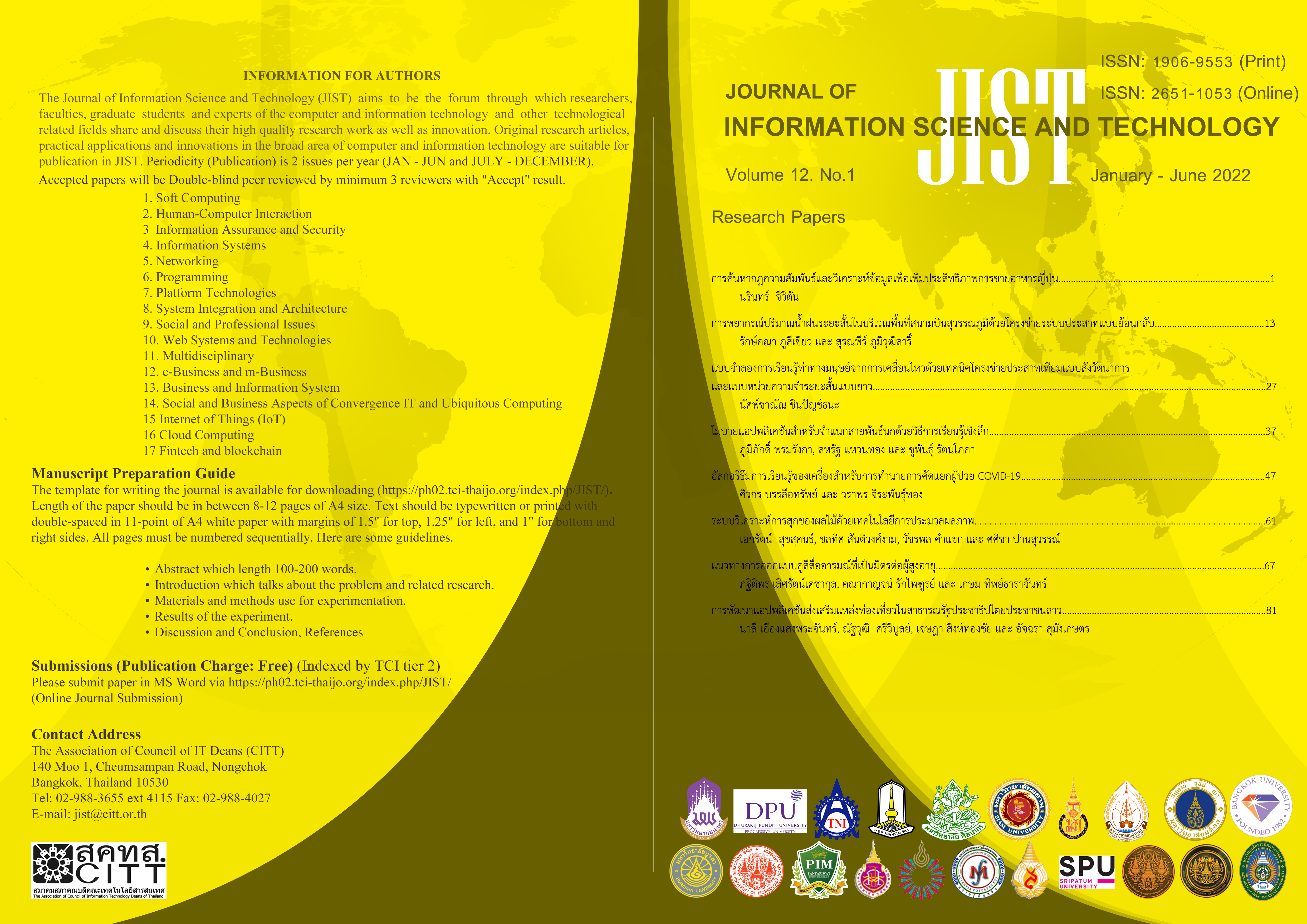แนวทางการออกแบบคู่สีสื่ออารมณ์ที่เป็นมิตรต่อผู้สูงอายุ
Main Article Content
บทคัดย่อ
ประชากรผู้สูงอายุไทยและโลกเพิ่มขึ้นอย่างต่อเนื่อง ความร่วมมือกันในการดูแลผู้สูงอายุจากหลากหลายมิติจะช่วยทำให้ผู้สูงอายุสามารถดำรงชีวิตได้อย่างมีคุณภาพ มีความสุขและปลอดภัย หนึ่งในปัญหาที่มาพร้อมกับความเสื่อมทางกายภาพและรบกวนการดำเนินชีวิตประจำวันของผู้สูงอายุคือการมองเห็นแยกแยะที่ยากขึ้น ซึ่งการเลือกใช้สีมีส่วนสำคัญในการช่วยทำให้มองเห็นวัตถุได้ดียิ่งขึ้น ลดอุบัติเหตุ และยังช่วยในการสื่อสารข้อมูลกับผู้สูงอายุได้อย่างมีประสิทธิภาพ งานวิจัยนี้ได้พัฒนาต่อยอดการนำสีที่เชื่อมโยงกับอารมณ์ความรู้สึกจาก Color Image Scale มาทดสอบการมองเห็นคู่สีโดยผู้สูงอายุ และนำมาวิเคราะห์ร่วมกับข้อมูลสี ได้แก่ อัตราส่วนความคมชัด (Contrast Ratio), ความแตกต่างของสี (Color Difference), ความแตกต่างของความสว่าง (Brightness Difference) และจัดกลุ่มตามโทนสี เรียงลำดับสีตามความสว่าง ความเข้มสี และอัตราส่วนความคมชัด รวบรวมเป็นคู่สีที่ควรหลีกเลี่ยงและคู่สีที่เป็นมิตรต่อผู้สูงอายุ นำเสนอแนวทางการออกแบบคู่สีสื่ออารมณ์ที่เป็นมิตรต่อผู้สูงอายุ เพื่อง่ายต่อการออกแบบสื่อดิจิทัลและการนำไปประยุกต์ใช้งานด้านต่าง ๆ
Article Details
This work is licensed under a Creative Commons Attribution-NonCommercial-NoDerivatives 4.0 International License.
I/we certify that I/we have participated sufficiently in the intellectual content, conception and design of this work or the analysis and interpretation of the data (when applicable), as well as the writing of the manuscript, to take public responsibility for it and have agreed to have my/our name listed as a contributor. I/we believe the manuscript represents valid work. Neither this manuscript nor one with substantially similar content under my/our authorship has been published or is being considered for publication elsewhere, except as described in the covering letter. I/we certify that all the data collected during the study is presented in this manuscript and no data from the study has been or will be published separately. I/we attest that, if requested by the editors, I/we will provide the data/information or will cooperate fully in obtaining and providing the data/information on which the manuscript is based, for examination by the editors or their assignees. Financial interests, direct or indirect, that exist or may be perceived to exist for individual contributors in connection with the content of this paper have been disclosed in the cover letter. Sources of outside support of the project are named in the cover letter.
I/We hereby transfer(s), assign(s), or otherwise convey(s) all copyright ownership, including any and all rights incidental thereto, exclusively to the Journal, in the event that such work is published by the Journal. The Journal shall own the work, including 1) copyright; 2) the right to grant permission to republish the article in whole or in part, with or without fee; 3) the right to produce preprints or reprints and translate into languages other than English for sale or free distribution; and 4) the right to republish the work in a collection of articles in any other mechanical or electronic format.
We give the rights to the corresponding author to make necessary changes as per the request of the journal, do the rest of the correspondence on our behalf and he/she will act as the guarantor for the manuscript on our behalf.
All persons who have made substantial contributions to the work reported in the manuscript, but who are not contributors, are named in the Acknowledgment and have given me/us their written permission to be named. If I/we do not include an Acknowledgment that means I/we have not received substantial contributions from non-contributors and no contributor has been omitted.
References
National Legislative Assembly of Thailand, “Aged Society: National Agenda,” 2018. [Online]. Available: https://www.senate.go.th/document/Ext17951/17951564_0004.PDF [Accessed Feb. 10, 2022].
United Nations, Department of Economic and Social Affairs, Population Division, World Population Prospects 2019: Data Booklet (ST/ESA/SER.A/424). 2019. [Online]. Available: https://population.un.org/wpp/Publications/Files/WPP2019_DataBooklet.pdf [Accessed Feb. 10, 2022].
L. Pukkhaow, P. Saenprasarn, and K. Huttrungsri, “Developing model of generosity participatory nursing among cataract surgery patients as of Swanson’s theory, Pathum thani hospital,” Journal of Health Science, vol. 29, no. 5, pp. 864–875, Sep. - Oct. 2020.
Japanese Society for Cataract Research. “Cataract self-diagnosis test.” jscr.net. http://www.jscr.net/ippan/page-010.html (accessed Jan. 23, 2022). [Accessed Feb. 10, 2022].
J. Jeawkok, S. Mudadum, and K. Kammaluan, “Family competency in postoperative care of senile cataracts patients,” Hatyai Academic Journal, vol. 13, no. 1, pp. 35–45, Jan. - Jun. 2015.
Suwa Branch of the Youth Committee of the Architects Association of Nagano Prefecture, “Elderly-friendly Color Plan,” 2001. [Online]. Available: https://www.arcsuwa.com/wp-content/uploads/2020/03/koureisyaniyasasii.pdf [Accessed Feb. 10, 2022].
Aichi Prefecture, “Universal Design Guidebook for Visual Information,” 2018. [Online]. Available: https://www.pref.aichi.jp/uploaded/life/283070_1021830_misc.pdf [Accessed Feb. 10, 2022].
Fukushima Prefecture, “Color Universal Design Guidebook,” [Online]. Available: https://www.pref.fukushima.lg.jp/uploaded/attachment/2574.pdf [Accessed Feb. 10, 2022].
Tottori Prefecture, “Color Universal Design Guidebook,” [Online]. Available: https://www.pref.tottori.lg.jp/secure/954753/CDU01_CUD20.pdf [Accessed Feb. 10, 2022].
City of Sapporo, “Color Universal Design,” [Online]. Available: https://www.city.sapporo.jp/koho/color/documents/02_honbun1.pdf [Accessed Feb. 10, 2022].
Industrial Research Institute of Ishikawa, Kanazawa College of Art, and NPO Corporation Color Universal Design Organization, “Color Universal Design Guideline,” 2009. [Online]. Available: https://www.irii.jp/staff/home/mmm/cud/090915_cudguide.pdf [Accessed Feb. 10, 2022].
I. Kei, “Color universal design : Towards barrier-free design for diverse color visions,” Journal of Information Processing and Management, vol. 55, no. 5, pp. 307–317, Aug. 2012.
Model Color Palette for Color Universal Design Working Committee, “Model Color Palette for Color Universal Design Guide Book,” 2018. [Online]. Available: https://jfly.uni-koeln.de/colorset/CUD_color_set_GuideBook_2018.pdf [Accessed Feb. 10, 2022].
N. Sungvorawongphana, R. Subgranon, P. Pungrassamee, C. Sumngern, and T. Obama, “The color vision of elderly under difference illuminance,” The Journal of Faculty of Nursing Burapha University, vol. 23, no. 1, pp. 13–25, Jan. - Mar. 2015.
N. Tuaycharoen, W. Kornisranukul, and S. Namanee, “The effect of interior lighting on visibility of Thai elderly,” Academic Journal of Architecture, vol. 65, pp. 55–74, Jan. - Dec. 2016.
K. Maki, N. Tanaka, and M. Todome, “The compatibility of legibility and goodliness of color combination,” Journal of the Color Science Association of Japan, vol. 29, no.1, pp. 2–13, 2005.
J. Kawaguchi, S. Shoyama, T. Danno, and Y. Tochihara, “Effect of color discrimination ability and visual acuity in their living environments of the elderly,” Journal of Human and Living Environment, vol. 12, no. 1, pp. 21–26, 2005.
M. Miyamoto, “Color discrimination properties and color image of the elderly and young people,” Journal of the Color Science Association of Japan, vol. 30, no. 3, pp. 124–134, 2006.
S.-M. Gong and W.-Y. Lee, “Colour preference model for elder and younger groups,” Journal of the International Colour Association, vol. 18, pp. 33–42, 2017.
H. Nagumo, New Color Image Chart. Tokyo, Japan: Graphic-sha, 2016.
M. Yamamoto, Y.-H. Lim, N. Aoki, and H. Kobayashi, “On the preferred reproduction of flesh color in Japan and south Korea, investigated for all generation,” Journal of The Society of Photographic Science and Technology of Japan, vol. 65, no. 5, pp. 363–368, Sep. 2002.
World Wide Web Consortium, “Web Content Accessibility Guidelines (WCAG) 2.1,” 2018. [Online]. Available: https://www.w3.org/TR/WCAG21/. [Accessed Feb. 10, 2022].


